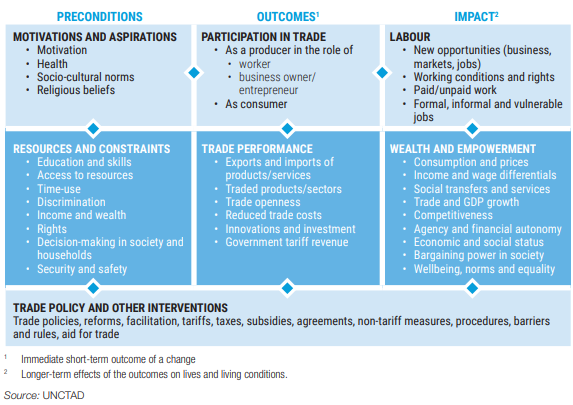Chapter 1 Introduction
In 2018, UNCTAD developed a conceptual framework for gender-in-trade statistics. The framework aims to help policymakers identify the key issues relevant to gender and international trade measurement and support national statistical offices to review existing data. The framework is derived from the Evidence and Data for Gender Equality (EDGE) framework for examining female entrepreneurship adopted to trade context.
The framework considers four elements:
- preconditions for the participation of women and men in trade: motivations, aspirations, resources,and constraints;
- outcomes reflecting the degree of involvement and roles of women and men in trade;
- impacts including the effects of trade on employment, division of labor, income, empowerment, and wellbeing; and
- trade policy and other government interventions that may influence gender equality.
The framework can guide national statistical offices in selecting data to analyse gender and trade at the macro- and/or micro-levels. Macro-level indicators on gender and trade focus on industry-level trade, employment, skills, earnings, and firm data. Ideally, however, statistics on gender-in-trade are calculated directly from microdata, but that requires more time and investment in data. Such detailed statistics would reflect the situation of women and men directly involved in international trade as employees, owners, and managers of exporting, importing, or two-way trading firms. These data could also be linked to other variables held by statistical offices, such as education, age, occupation, earnings, and other characteristics of individuals employed by trading companies, as well as information on the company, its industry class, productivity, size, and types of products produced, exported, and imported.

However, such data is not regularly produced by countries and thus not available for cross-country comparison. UNCTAD research and the conceptual framework for gender and trade statistics suggest that with already available data, employment and wages are the most straightforward channels to capture how trade affects female and male.
UNCTAD advocates for the accessibility of various indicators related to employment and wages. These are the share of female employment in trade, as well as earnings of female employees. Through these indicators, we can assess the gaps influenced by trade, both in terms of participation and pay. Ideally, our goal should be to identify trading firms at a micro level, link employees to these firms, and disaggregate data by gender, position within the firm, education, and skills.
Currently, employment and trade data are compiled and published by statistical offices at the industry level. However, the level of aggregation by industry in these data sources restricts the level of detail we can achieve in gender-in-trade indicators. Consequently, we have to make simplifying assumptions about the diversity of firms within trading industries, as not all firms within a particular industry engage in trade to the same extent. Additionally, UNCTAD endeavors to promote the availability of gender-in-trade data for all countries, which vary in terms of data availability and level of detail. This necessitates further compromises in terms of linking data across different domains.
Therefore, UNCTAD identifies a list of available gender-in-trade indicators that can be compiled on the global level. The list provided here aims to maximize the number of countries and level of detail while minimizing the effort required to link data at the micro level. It utilizes only what is available in databases of international organizations and aligns the data with industry-level breakdowns of sex in terms of both labor force participation and wages. The approach here builds on the idea of combining disaggregated (micro statistics) with macro-level international trade and input-output models.